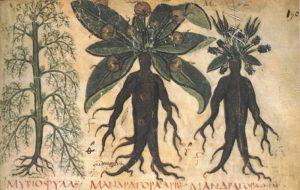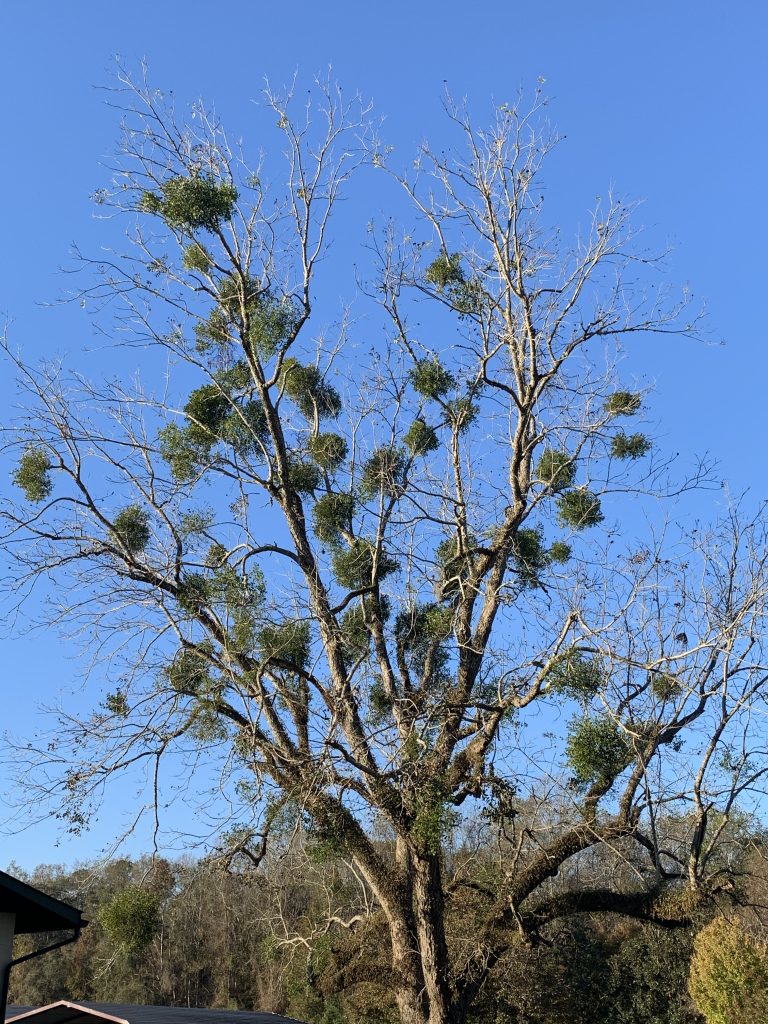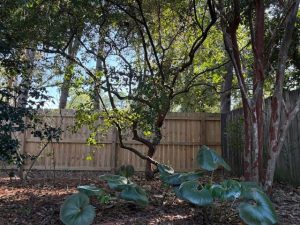
by Carrie Stevenson | Dec 18, 2024

A large Carolina wolfberry shrub thrives near St. Marks’ lighthouse at the wildlife refuge. Photo credit: Carrie Stevenson, UF IFAS Extension
I was lucky enough to spend a weekend in November exploring a lovely, low-key stretch of northwest Florida. We hiked trails and took the boat tour at Wakulla Springs State Park, marveling at the numerous alligators and admiring birds and a slow-moving manatee. We also hiked through St. Marks National Wildlife Refuge, which is home to a nearly 200-year-old lighthouse and keeper’s house, which have a fascinating history of their own.

The brilliant red, and edible, berry of the Carolina wolfberry is ripe in late fall/early December. Photo credit: Carrie Stevenson, UF IFAS Extension
Exploring the shoreline of Apalachee Bay behind the lighthouse, we watched fiddler crabs run the salt flats and herons quietly stalk their prey. Always on the lookout for something new, I noticed a large shrub growing several yards back from the beach. It looked like a cross between a rosemary and a holly, with delicate lavender/purple flowers and brilliant red teardrop-shaped fruit. I’d never seen it before.

Map of the natural range of Carolina wolfberry in Florida. Figure courtesy of the Florida Native Plant Society.
After a quick investigation, I learned it was a Carolina wolfberry, aka Carolina deserthorn, aka Christmas berry (Lycium carolinianum). The invasive species coral ardisia (Ardisia crenata) is also known in some areas as Christmas berry—this is why scientific names are so useful—but that is not the plant we saw at St. Marks. The native Carolina wolfberry was located right where you might expect it, on dry coastal scrub, in view of the saltwater it easily tolerates. Its native range in Florida starts along the coastline east of here, particularly Bay and Wakulla counties and all the way down around the state.

The delicate lavender flower of the Carolina wolfberry is a popular nectar source for native butterflies. Photo credit: Peggy Romfh
The tall shrub is evergreen, with leaves adapted into a long, thin, slightly succulent near-needle shape. This leaf form helps hold water in a dry, salty environment and prevents evaporation. The tips of the shrub’s branches have thorns, hence the common name “desert-thorn.” Carolina wolfberry produces those attractive little purple blooms in the fall, providing nectar for several species of native butterflies. In late fall/early winter, the brilliant red fruits show up. They are less than an inch long and reminiscent of peppers. When ripe, the fruit are edible and are described as sweet and tomato-like. The fruit are not only popular for human consumption, but also for birds, deer, and raccoons. Just before we walked down the beach, another visitor saw a bobcat disappear into the shrub, which provides cover for many additional species besides those who eat it directly.

Illustration from a 15th century plant medicine book showing the mandrake, a member of the Solanaceae family.
Carolina wolfberry is a member of the Solanaceae family, aka nightshade (sometimes referred to as “deadly nightshade”). Other relatives include edible tomatoes, peppers, potatoes, eggplant, and groundcherry. The “deadly” part refers to related species like belladonna and mandrake, from which toxic poisons can be extracted. If you’re looking for a fascinating historical deep dive into these plants’ connection to witches, Shakespeare, and the death of multiple Roman emperors, look no further than the US Forest Service’s web page on the “Powerful Solanaceae” family!

by Danielle S. Williams | Dec 5, 2024
A kiss under the mistletoe…a timeless holiday tradition that we’ve all heard of. If you look around, you’ll be sure to find some growing on the branches of several different species of hardwood trees throughout the Panhandle. This same mistletoe is often harvested and brought inside to add a festive touch to holiday decorations.

Mistletoe hanging in pecan tree. Photo credit: Danielle Williams.
The species we have here is known as American or oak mistletoe. It only grows in deciduous trees that shed their leaves annually. While mistletoe has over 200 host plants, you’ll find it most commonly in oaks, maples, and pecans. Look for a green, ball shaped mass about 3’ wide in the tops of trees. Each mass is an individual mistletoe plant, and some trees may have a few or many.

Mistletoe. UF/IFAS Photo by Tyler Jones.
Mistletoe is a small, evergreen shrub with white berries. It is considered a hemi-parasitic plant because it can produce some of its own food through photosynthesis, but it also relies on its host tree for water and nutrients. Most healthy trees can tolerate mistletoe without suffering any significant harm. However, trees that become severely infested with mistletoe can become weakened and decline in health, especially if the tree is already stressed by pests, drought or disease.

Pecan Tree Infested with Mistletoe. Photo credit: Danielle Williams.
If you have mistletoe growing on trees in your yard, the best way to support the trees is to maintain their overall health through proper watering, fertilization and pest management. If you suspect trees on your property are suffering from mistletoe, you can prune the infected branches. Since mistletoe roots from its host tree, simply cutting it flush with the branch will not kill it. You can remove the roots by pruning at least six inches below the point of attachment.
While some may consider mistletoe to be a nuisance, it does provide ecological benefits. Mistletoe serves as a valuable resource to our wildlife, primarily birds and insects. Oak mistletoe is the only food source for the larvae of the great purple hairstreak butterfly.
If you are considering harvesting mistletoe this winter to use for decoration, be sure to place it carefully. Mistletoe berries and all parts of the plant are poisonous to humans so keep plants and decorations out of the reach of children and pets. For more information on mistletoe, contact your local UF/IFAS Extension Office.

by Beth Bolles | Oct 17, 2024
UF IFAS Extension Escambia County was recently able to offer a native tree and shrub giveaway to our community. A county partner had some grant funding remaining and chose a nice selection of plants grown by a local native nursery. After seeing the plant selection, I was really excited that a few participating homeowners had the opportunity to take home one of my favorite native plants, the Sparkleberry, Vaccinium arboretum.

The Sparkleberry in the corner of my back yard. Photo by Beth Bolles, UF IFAS Extension Escambia County
Twenty-three years ago, I saved a sparkleberry on my new home lot because I loved this native tree. It has interest in all seasons in my opinion, including flowers, small fruit for wildlife, attractive bark, and an interesting shape as it matures. It has been a slower growing tree than others in my yard but I have enjoyed watching the tree develop its form and the bark develop the beautiful flaky cinnamon-brown look.

Sparkleberry bark and structure are attractive features in the landscape. Photo by Beth Bolles, UF IFAS Extension Escambia County.
The small tree is now about 12 feet tall and has never had any issues in the sandy, well drained soil. It can tolerate some moisture as long as the soil drains well. A grouping of trees from my neighbor’s lot keeps the plant in partial shade and we can often find sparkleberry specimens in the filtered light of woods. It can tolerate a sunnier location if that is the spot you have available for a small tree.
In addition to our enjoyment of this native tree, pollinators and other animals will appreciate the flower nectar, pollen, and berries. If you have a native nursery close to your home, be sure to ask for your own Sparkleberry if your site is suitable.

by Daniel J. Leonard | Sep 19, 2024
Problem areas in the landscape – everyone has them. Whether it’s the spot near a drain that stays wet or the back corner of a bed that sunshine never touches, these areas require specialized plants to avoid the constant frustration of installing unhealthy plants that slowly succumb and must be replaced. The problem area in my landscape was a long narrow bed, sited entirely under an eave with full sun exposure and framed by a concrete sidewalk and a south-facing wall. This bed stays hot, it stays dry, and is nigh as inhospitable to most plants as a desert. Enter a plant specialized to handle situations just like this – Yarrow ‘Moonshine’.
Yarrow (Achillea spp.) is a large genus of plants, occurring all over the globe. To illustrate, Common Yarrow (Achillea millefolium) is native to three different continents (North America, Europe, and Asia), making it one of the most widely distributed plants in the world. And though it was commonly grown and used in antiquity for medical purposes (the genus name Achillea is a reference to Achilles, who supposedly used the plant as a wound treatment for himself and his fellow Greek soldiers), I and most of you are probably more interested in how it looks and performs in the landscape.

‘Moonshine’ Yarrow foliage.
All species of Yarrow share several ornamental traits. The most obvious are their showy flowers, which occur as large, flattened “corymbs” and come in shades of white, pink, red, and yellow. I selected the cultivar ‘Moonshine’ for my landscape as it has brilliant yellow flowers that popped against the brown wall of the house. Equally as pretty and unique is the foliage of Yarrow. Yarrow leaves are finely dissected, appearing fernlike, are strongly scented, and range in color from deep green to silver. Again, I chose ‘Moonshine’ for its silvery foliage, a trait that makes it even more drought resistant than green leaved varieties.

‘Moonshine’ Yarrow inflorescence.
If sited in the right place, most Yarrow species are easy to grow; simply site them in full sun (6+ hours a day) and very well drained soil. While all plants, Yarrow included, need regular water during the establishment phase, supplemental irrigation is not necessary and often leads to the decline and rot of Yarrow clumps, particularly the silver foliaged varieties like ‘Moonrise’ (these should be treated more like succulents and watered only sparingly). Once established, Yarrow plants will eventually grow to 2-3’ in height but can spread underground via rhizomes to form clumps. This spreading trait enables Yarrow to perform admirably as a groundcover in confined spaces like my sidewalk-bound bed.
If you have a dry, sunny problem spot in your landscape and don’t know what to do, installing a cultivar of Yarrow, like ‘Moonshine’, might be just the solution to turn a problem into a garden solution. This drought tolerant, deer tolerant, pollinator friendly species couldn’t be easier to grow and will reward you with summer color for years to come. Plant one today. For more information on Yarrow or any other horticultural question, contact your local UF/IFAS County Extension Office.

by Ray Bodrey | Sep 4, 2024
Fall is a season that is synonymous for two great joys in life…..football games and the changing leaf colors! However, in Florida we just don’t have the incredible burst of vivid fall leaf color as our northern neighbors enjoy each year, but we do have enough temperate region plants that can give us some seasonal change in foliage.
So what makes this brilliant display of autumn leaf color anyway? This seasonal change is brought on by a few variables, such as lower temperatures, shorter photo period/shorter days and chemical pigments found in leaf tissues. Some of the pigments that give autumn leaves their bright colors are actually present in the leaves as soon as they unfold as flush in early spring. But, during spring and summer, when the plants are growing vigorously, a green-colored material called chlorophyll dominates and shades out the other leaf pigments.
Chlorophyll plays on important role in a process called photosynthesis, which is the process by which plants capture energy from sunlight and manufacture food. Chlorophyll can also be found in water bodies and is an indicator of water quality. As plants get ready for cool season dormancy, the production on new chlorophyll decreases to almost being nonexistent. That’s when the before mentioned pigments, also called carotenoids, take over and make the leaves turn brilliant orange, red, purple and yellow.
There are some plants in the Florida’s landscape that do provide good fall color. Unlike most of the flowering shrubs, which hold their blossoms for only a brief period, the trees and shrubs that turn color in the fall will usually retain their varied hues for a month or more, depending on the weather.

Red Maple. Credit. UF/IFAS Extension
What are some examples of trees that will lend fall color in your Panhandle landscape?
- Shumard Oak
- Turkey Oak
- Ginkgo
- Hickory
- Golden Rain Tree
- Red Swamp Myrtle
- Dogwood
- Red Maple (see photo)
- Sweet Gum
- Black Gum
- Crape Myrtle
- Tulip Tree
- Bradford Pear
- Cypress
What about annuals that provide color in the fall? Petunias, pansies and snapdragons will be in full bloom over the next few months.

Firespike. Credit. UF/IFAS Extension
What about blooming perennials for fall? Salvia, firespike (see photo), chrysanthemum, beautyberry and holly are great for color in the fall and attract wildlife to your landscape.
A mix of these plants will ensure fall color in your landscape. For more information contact your local county extension office.
Information for this article was provided by Patrick Minogue, Forestry Specialist with UF/IFAS North Florida Research and Education Center, as well as the UF/IFAS Gardening Solutions: https://gardeningsolutions.ifas.ufl.edu/design/outdoor-living/gardening-for-fall-color/

by Joshua Criss | Aug 12, 2024
Managing your soil is easily the most critical task in gardening. Well-managed soils retain water and nutrients, making them available to your plants, thus enabling them to thrive. It may seem daunting, but with a bit of knowledge, you’ll quickly discover that soil management is much simpler than you thought. Soil management can be broken down into two major topics. The first is the physical properties outlined in a previous article, which may be found here. The second, and arguably more complicated of the two, are those chemical properties that drive plant growth.
The What and Why of Soil pH
When considering chemical properties, you first need to look at soil pH. This is the measure of acidity or alkalinity within your soil profile. Innate soil pH is a product of the parent material from which your soil has formed, which tends to be slightly acidic on the Panhandle. Testing is the only accurate way to measure your soil’s pH level and buffering capacity. Your county extension office will be happy to facilitate that testing.
So, why is pH so important to plant growth? You’ll want to manage your soil’s pH for two reasons. The first is that soil acidity greatly influences the form that fertilizers and herbicides take in your landscape. Put into context, if you add fertilizers into the soil with an incorrect pH, that fertilizer may not dissolve in the water present. It will thus be unavailable to your plants. Here is another example of putting the right plant in the right place. Some, such as centipedegrass, thrive in a low-nutrition environment created by a low pH, whereas most vegetable plant species and many other landscape species only want a slightly acidic environment. Placing plants that will grow in the natural pH of your soil is a great way to ensure success in your gardens.

UF/IFAS photo
Ok, you’ve tested your soil and discovered it is not optimal for the plants you want to grow. Fear not, as you can take some actions to adjust your soil’s inherent acidity levels. Keep in mind that any changes will be very localized and are temporary. To raise soil pH, you must apply some version of calcium, colloquially called liming. Your calcium source should be based on soil testing, as different types may also add needed nutrients. Most notably, dolomitic lime will change soil pH while adding magnesium. Soil testing will also tell you to provide the buffering capacity of your soil, which will dictate the amount needed to adjust the soil properly. Soil pH may also be lowered through elemental sulfur additions, but this process is very difficult and may become detrimental to plant growth through repeated application. In this instance, it may be preferable to address via plant selection versus pH adjustment.
How Does Soil Hold Onto Water and Nutrition
The other main consideration for soil chemical properties is cation exchange capacity or CEC. Now, this can be a very complicated topic. Put very simply, it refers to your soil’s ability to retain both water and applied nutrients. It’s important to understand as it holds components critical to plant growth in the root zone of said plants. This happens as there are negative charges on the surfaces of clay particles in your soil that latch onto the positive ions of applied fertilizers.

Photo: University of Georgia Extension
So, what about soils low in clay, such as those in Florida? Organic matter will help in this arena. It mimics clay’s properties and will retain nutrients better than your native soil. However, this is not a pass to add endless amounts of compost, as they come with a nutritive load that must be considered in your garden management plan. Adding 1-3 inches worked into your plant root zone is more than enough when establishing new gardens.
Understanding your soil is critical when gardening anywhere. In Florida, where soils are less than optimal, understanding how water and nutrients are retained and used by your plants will help avoid much frustration. For more information on soil management refer to these IFAS documents, or contact your local extension agent for additional information on this and any topic regarding your gardens and more.






















